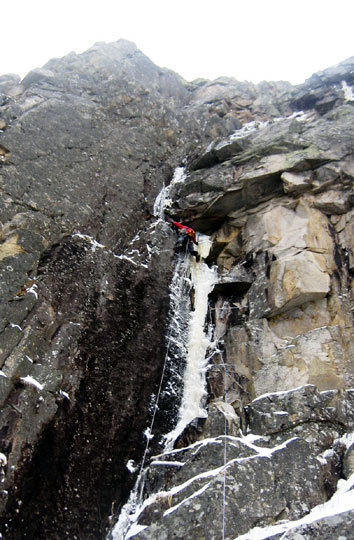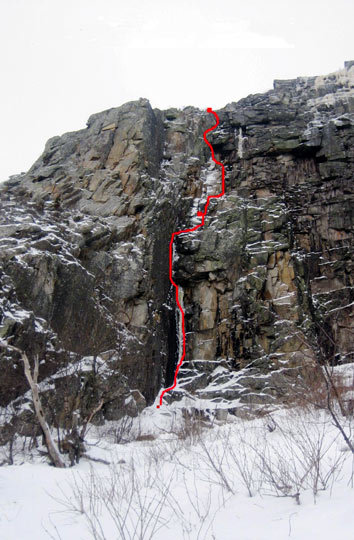
Will Mayo climbing thin ice on the first pitch of Mean Streak (WI6 M7, 450′), Cannon Cliff, New Hampshire. The line–likely the most difficult and sustained on the cliff–he established with Andy Tuthill, prolific Cannonite, on December 11, 2007. [Photo] Andy Tuthill
Editor’s Note: Cannon Cliff, profiled in Issue 21, is the tallest and arguably “most alpine” wall in New England. First climbed in 1928, an explosion of winter development in the 1970s instituted some of the region’s classics, such as The Black Dike (IV NEI4+) and Omega (IV NEI5+). Other mixed classics have been climbed over the years like the Quartet Ice Hose (NEI4+ 5.8) and, more recently, Prozac (NEI5+ M6 R, Gilmore-Mahoney, 2002), which is just right of Omega. On December 11, 2007, Will Mayo and Andy Tuthill added a mixed line (which, to their knowledge, had never been attempted before) 200 feet left of Omega, establishing what is perhaps the most difficult and sustained mixed line on the cliff.
Last week I climbed Omega. Twice. It’s my favorite ice climb and it’s so rarely in shape that I couldn’t resist doing it a second time with my friend Andy Tuthill. Andy had yelled out at some point during the day, “There’s your new route!”, gesturing toward the dark corner system that is the north side of the Henderson Buttress. Yesterday (December 11), Andy and I returned to Cannon Cliff in Franconia Notch to try this mixed line to the left of the classic Omega. My friends and I have looked at it over the years and wondered each time we ventured up into the Omega amphitheater. (I’ve done Omega eight times and have backed off it at least as many times; so, the line has withstood quite a lot of visual scrutiny.) Turns out, it goes–and it’s one Mean Streak (WI6 M7, 450′). We climbed it in three demanding pitches (P1: WI6 M7, 140′; P2: M6+, 100′; P3: M6+, 210′), each requiring heavy ironwork and our full attention.
We carried a full rack of pins, single rack of nuts, single rack of cams, a few short screws and 70-meter ropes. We climbed the three sustained pitches traditionally: ground-up, free, onsight, and without leaving a stitch of fixed protection behind. We did, however, drop one lost arrow piton on the first pitch and one dyneema sling into the depths of a wide crack behind the giant shattered flake at the very top of the wall–litter bugs!
The ice is scant but exciting; the rock is of reasonably good quality with mostly good hooking and torque-ing the whole way. There is some loose rock–especially toward the top–but the belays are protected from falling ice and rock. An appealing ice smear variation to the right of our third pitch exists. We felt it was a little too lean during our ascent and opted to drytool the steep rock corner directly to the top.

The Mean Streak line. The unclimbed variation mentioned is the smear of ice roughly three quarters up the face. Mayo and Tuthill elected not to climb it, judging it dangerously thin. [Photo] Andy Tuthill
After an easy bulge of ice above the steep bit we reached the trees and burrowed right (north-northeast) along the top of the cliff through the snow-covered trees for ca. 450 feet to the top of Omega. We rappelled Omega just before dark using the v-threads from our ascents last week.
Mean Streak, a mere addition to Andy’s long list of first ascents on Cannon, marks my very first first ascent on Cannon, one of my favorite cliffs. Graced with splitter cracks, giant jigsaw-puzzle flakes, thin smears of ice and a fragile column, the route is destined to become a traditional mixed climbing classic. To that end, Mean Streak is as close as we have come to real alpine engagement (sans packs, avalanches, seracs, crevasses, and soggy sleeping bags) in the sleepy hollows of New England.